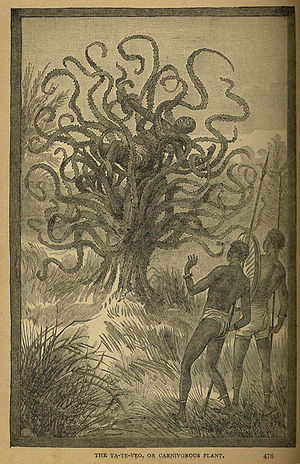As humans, many of us eat meat without giving it a second thought. I’ll be honest. I enjoy a good steak; I love fresh fish; and my favorite dish is fried chicken.
However, over the years, many people have become vegetarians as a show of respect for the animal kingdom and because it is believed to be healthier overall. However, many people believe that there are plants out there that would gladly dine on us, given the opportunity.
The scientist Charles Darwin spent many years studying the phenomena of carnivorous plants. They fascinated him. Some even claim it was an obsession. But do such plants – – or trees – – really exist? The answer isn’t so clear.
According to Darwin’s theories, there are a number of man eating plants in the world. Many live in wet areas where water can easily wash away the nutrients that the plants need in order to thrive and grow. Therefore, over the years they have had to adapt and make use of whatever they could find in their natural environment. Most have developed mechanisms to ensnare small animals, which they in turn use to draw the nutrients they require – – from their blood.
It really isn’t such a big leap from there to larger animals and perhaps even to man himself. In fact, the people of Madagascar will tell you that switch over has already taken place. Many in the area have claim to have witnessed trees, with long snake-like tendrils that envelop humans, strangle them, and then engulf their bodies inside to draw out the nutrient requirements from their blood.
Some go so far as to claim that the Mdoko tribe sacrifices human beings to the tree, which they consider to be one of their gods. But is that true?
A German tourist by the name of Carl Liche says he witnessed such an event in 1878. He even wrote about it in the South Australian Register in 1881. And he wasn’t alone. Former Michigan Governor, Chase Osborn, reported that locals in the area were aware of the tree and knew to give it a wide birth.
Whether or not those claims are true is a matter of speculation. The many reports that have been logged certainly do not constitute proof. No evidence that such trees exist has been caught in photos or on film. Is it possible? Yes. It is probable? Who knows?
The most famous man-eating plant of all time is the Venus Flytrap. It was even been immortalized on Broadway and on the silver screen in “Little Shop of Horrors.”
The strange plant, which grows close to the ground, features a circle of leaves from which grows a long stem of white flowers. The leaves feature a green, clamshell looking protrusion that actually has something that resembles teeth.
Inside the strange protrusion are small, fine hairs that are reported to be extremely sensitive. So when an insect lands on the plant and comes in contact in any way with those hairs, it springs the so-called “trap.” The clamshell protrusion opens up to quickly engulf the trapped creature. Before it has time to get its bearings and attempt escape, the plant lets off digestive juices that quickly destroys its victim.
Many believe that the flytrap is not of this earth. Folklore claims that it is the result of meteors that have landed on earth and interacted with our environment, causing a mutation. Such claims have never been proven.
Another similar carnivorous plant is called simply the Pitcher Plant. Unlike the flytrap, this plant grows taller and features a container that is shaped like a vase. That is covered over the top with a protrusion that resembles a hood.
The hood releases a very sweet-smelling fragrance that leads insects to believe that the plant has nectar to offer them. Once drawn to the area, however, they soon discover that the protrusion has a waxy interior that quickly traps them inside. Because it is slippery, they are unable to escape.
Instead, they continue to slide down the vase-life protrusion into a waiting vat of digestive materials. Once they fall in, there is no escape.
Another plant called the Yellow Trumpet, traps its prey with a sweet nectar that instantly paralyzes them so that it can consume the victim without any problem. Similarly, the Sundew Plant uses nectar to attract insects to land. Once they do, a sticky substance on the leaves holds the victim in place while long, tendril hairs fold over to suffocate it as digestive fluids are released to gather the nutrients the plant wants and needs.
Many believe that the Madagascar man eating tree might, in fact, be a plant that is commonly called the Corpse Flower. It grows to be anywhere from seven to ten feet in height and features a huge flower that can be more than three feet across. It certainly looks as though it could eat a human being.
The plant reportedly releases an unbelievable aroma that draws insects, animals, and even humans to it. Once its intended victim is close enough, the plant releases pollen that quickly engulfs the intended victim. However, there is no evidence that the plant uses its victim for anything more than spreading it pollen. It isn’t carnivorous. Plus, there is no evidence of that particular plant growing in Madagascar.
It should be noted that Madagascar isn’t the only place in the world to claim man eating trees or even trees that drink blood. Similar stories have also been told in Central and South America as well as in Mexico.
In Central America, a tree called the Yate-Veo supposedly impales its victims with sharp looking spikes that grow at the end of some branches. It is reported that it can draw the blood of the victim through those spikes.
Trees in Nicaraguan supposedly capture their victims by entangling them in vines that grow throughout the plant. Once captured, the victim is held in place by a sticky substance that dissolves the flesh and allows the tree to absorb the needed nutrients.
With all of the information available on these plants and trees, however, there is no documentation that any of them have actually eaten a human. Insects, yes. Small reptiles like lizards, perhaps. But humans? Not likely!
In truth, humans are far more deadly to these plants than they might ever be to human beings. Many of them grow in areas that man seeks to develop; taking away their homes, displacing or destroying them. Additionally, because of their variety in nature, such plants are highly collectible; assuring that many fall prey to us rather than the other way around.





